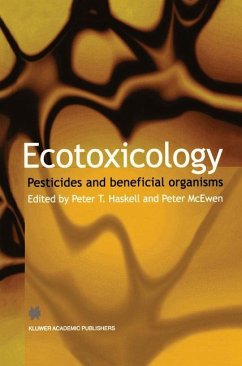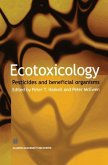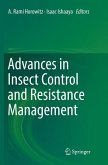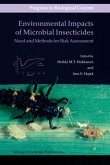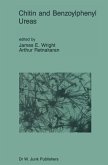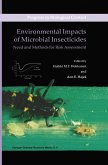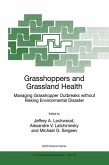Ecotoxicology
Pesticides and beneficial organisms
Herausgegeben:Haskell, Peter T.; McEwen, Peter
Ecotoxicology
Pesticides and beneficial organisms
Herausgegeben:Haskell, Peter T.; McEwen, Peter
- Broschiertes Buch
- Merkliste
- Auf die Merkliste
- Bewerten Bewerten
- Teilen
- Produkt teilen
- Produkterinnerung
- Produkterinnerung
Following the original initiative of the International Organisation for Biological Control some 15 years ago, research groups and agrochemical companies have been investigating the effects of pesticides on beneficial organisms, devising laboratory and field test methods and lately developing protocols for regulatory testing requirements in Europe. This work, and the application of agreed protocols for testing, is of crucial importance to the environmentally acceptable use of pesticides and to the further development of Integrated Pest Management systems, and the objective of this book is to…mehr
Andere Kunden interessierten sich auch für
![Ecotoxicology Ecotoxicology]() Peter T. Haskell / Peter McEwen (Hgg.)Ecotoxicology121,99 €
Peter T. Haskell / Peter McEwen (Hgg.)Ecotoxicology121,99 €![Advances in Insect Control and Resistance Management Advances in Insect Control and Resistance Management]() Advances in Insect Control and Resistance Management112,99 €
Advances in Insect Control and Resistance Management112,99 €![Environmental Impacts of Microbial Insecticides Environmental Impacts of Microbial Insecticides]() H.M.T Hokkanen / Ann E. Hajek (eds.)Environmental Impacts of Microbial Insecticides112,99 €
H.M.T Hokkanen / Ann E. Hajek (eds.)Environmental Impacts of Microbial Insecticides112,99 €![Chitin and Benzoylphenyl Ureas Chitin and Benzoylphenyl Ureas]() Chitin and Benzoylphenyl Ureas41,99 €
Chitin and Benzoylphenyl Ureas41,99 €![Environmental Impacts of Microbial Insecticides Environmental Impacts of Microbial Insecticides]() Environmental Impacts of Microbial Insecticides121,99 €
Environmental Impacts of Microbial Insecticides121,99 €![Biological Control Biological Control]() Roy Van DriescheBiological Control161,99 €
Roy Van DriescheBiological Control161,99 €![Grasshoppers and Grassland Health Grasshoppers and Grassland Health]() LockwoodGrasshoppers and Grassland Health121,99 €
LockwoodGrasshoppers and Grassland Health121,99 €-
-
-
Following the original initiative of the International Organisation for Biological Control some 15 years ago, research groups and agrochemical companies have been investigating the effects of pesticides on beneficial organisms, devising laboratory and field test methods and lately developing protocols for regulatory testing requirements in Europe.
This work, and the application of agreed protocols for testing, is of crucial importance to the environmentally acceptable use of pesticides and to the further development of Integrated Pest Management systems, and the objective of this book is to review the origins and progress of the research - what has been accomplished, what is the current position and what still needs to be done.
This work, and the application of agreed protocols for testing, is of crucial importance to the environmentally acceptable use of pesticides and to the further development of Integrated Pest Management systems, and the objective of this book is to review the origins and progress of the research - what has been accomplished, what is the current position and what still needs to be done.
Produktdetails
- Produktdetails
- Verlag: Springer, Berlin
- Softcover reprint of the original 1st ed. 1998
- Seitenzahl: 468
- Erscheinungstermin: 31. Oktober 2012
- Englisch
- Abmessung: 235mm x 155mm x 26mm
- Gewicht: 704g
- ISBN-13: 9781461376538
- ISBN-10: 146137653X
- Artikelnr.: 37477556
- Herstellerkennzeichnung Die Herstellerinformationen sind derzeit nicht verfügbar.
- Verlag: Springer, Berlin
- Softcover reprint of the original 1st ed. 1998
- Seitenzahl: 468
- Erscheinungstermin: 31. Oktober 2012
- Englisch
- Abmessung: 235mm x 155mm x 26mm
- Gewicht: 704g
- ISBN-13: 9781461376538
- ISBN-10: 146137653X
- Artikelnr.: 37477556
- Herstellerkennzeichnung Die Herstellerinformationen sind derzeit nicht verfügbar.
1 Introduction.- 2 Issues associated with pesticide toxicology and arthropod natural enemies in the pre- and post-registration stages of chemical development.- 3 The initiative of the IOBC/WPRS Working Group on Pesticides and Beneficial Organisms.- 4 Reducing insecticide use in plant protection in Israel: policy and programmes.- 5 Pesticides and natural enemies: Malaysia perspectives.- 6 Can we achieve harmonization of regulatory requirements in Europe?.- 7 Introduction.- 8 Standard laboratory methods to test the side-effects of pesticides.- 9 Development and ring-testing of a standardized laboratory test for parasitic wasps, using the aphid-specific parasitoid Aphidius rhopalosiphi.- 10 Current status of a ring-tested method to determine pesticide effects on the predatory mite Typhlodromuspyri (Scheuten) (Acarina: Phytoseiidae) in the laboratory.- 11 Testing side-effects of pesticides on carabid beetles: a standardized method for testing ground-dwelling predators in the laboratory forregistration purposes.- 12 Testing side-effects of pesticides on spiders (Pardosa spp.) in the laboratory.- 13 Two-step test system using the plant-dwelling non-target insect Coccinella septempunctata to generate data for registration of pesticides.- 14 Side-effects of pesticides on larvae of Chrysoperla carnea (Neuroptera, Chrysopidae): actual state of the laboratory method.- 15 Field studies with pesticides and non-target arthropods in orchards.- 16 Accuracy and efficiency of sequential pesticide testing protocols for phytoseiid mites.- 17 Using a sequential testing scheme under laboratory and field conditions with the bumble bee Bombusterrestris to evaluate the safety of different groups of insecticides.- 18 Testing effects of pesticides on adult carabid beetles in semi-field and field experiments.- 19 The value of large-scale field trials for determining the effects of pesticides on the non-target arthropod fauna of cereal crops.- 20 Comparing pesticide effects on beneficials in asequential testing scheme.- 21 Introduction.- 22 Aims and consequences of regulatory risk management in Europe: a discussion.- 23 Effects of plant protection products on beneficial organisms: the current authorization procedure in Germany.- 24 Labelling and risk management strategies for pesticides and terrestrial non-target arthropods: a UK proposal.- 25 Pesticides and beneficial arthropods: an industry perspective.- 26 Honey bees in Europe: lessons for other terrestrial non-target arthropods.- 27 Risk assessment and management: is it working? An NGO perspective.- 28 Comparative impact of insecticide treatments on beneficial invertebrates in conventional and integrated farming systems.- 29 Relative toxicity of pesticides to pest and beneficial insects in potato crops in Victoria, Australia.- 30 The cumulative effect on populations of linyphid spiders and carabid beetles of insecticide sprays applied to two consecutive winter wheat crops.- 31 The MAFF SCARAB project: seven years of pesticide side-effects research on arthropods.- 32 A dynamic risk assessment for beneficial insects in cereal canopies.- 33 Introduction.- 34 Implications of insecticide resistance for interactions between pests, natural enemies and pesticides.- 35 Approaches for extrapolating pesticide side-effects between arthropod species: how much do we know?.- 36 Application of pheromones: toxicological aspects, effects on beneficials and state of registration.- 37 The importance of the population perspective for the evaluation of side-effects of pesticides on beneficial species.- 38 Introduction.- 39 The Asian initiative in pesticides and beneficials testing.- 40 The impact of locust and grasshopper control on beneficial arthropods in West Africa.- 41 Impact of insecticides on herbivore-natural enemy communities in tropical rice ecosystems.- 42 Development of decision-making tools for vegetable farmers in Southeast Asia.
1 Introduction.- 2 Issues associated with pesticide toxicology and arthropod natural enemies in the pre- and post-registration stages of chemical development.- 3 The initiative of the IOBC/WPRS Working Group on Pesticides and Beneficial Organisms.- 4 Reducing insecticide use in plant protection in Israel: policy and programmes.- 5 Pesticides and natural enemies: Malaysia perspectives.- 6 Can we achieve harmonization of regulatory requirements in Europe?.- 7 Introduction.- 8 Standard laboratory methods to test the side-effects of pesticides.- 9 Development and ring-testing of a standardized laboratory test for parasitic wasps, using the aphid-specific parasitoid Aphidius rhopalosiphi.- 10 Current status of a ring-tested method to determine pesticide effects on the predatory mite Typhlodromuspyri (Scheuten) (Acarina: Phytoseiidae) in the laboratory.- 11 Testing side-effects of pesticides on carabid beetles: a standardized method for testing ground-dwelling predators in the laboratory forregistration purposes.- 12 Testing side-effects of pesticides on spiders (Pardosa spp.) in the laboratory.- 13 Two-step test system using the plant-dwelling non-target insect Coccinella septempunctata to generate data for registration of pesticides.- 14 Side-effects of pesticides on larvae of Chrysoperla carnea (Neuroptera, Chrysopidae): actual state of the laboratory method.- 15 Field studies with pesticides and non-target arthropods in orchards.- 16 Accuracy and efficiency of sequential pesticide testing protocols for phytoseiid mites.- 17 Using a sequential testing scheme under laboratory and field conditions with the bumble bee Bombusterrestris to evaluate the safety of different groups of insecticides.- 18 Testing effects of pesticides on adult carabid beetles in semi-field and field experiments.- 19 The value of large-scale field trials for determining the effects of pesticides on the non-target arthropod fauna of cereal crops.- 20 Comparing pesticide effects on beneficials in asequential testing scheme.- 21 Introduction.- 22 Aims and consequences of regulatory risk management in Europe: a discussion.- 23 Effects of plant protection products on beneficial organisms: the current authorization procedure in Germany.- 24 Labelling and risk management strategies for pesticides and terrestrial non-target arthropods: a UK proposal.- 25 Pesticides and beneficial arthropods: an industry perspective.- 26 Honey bees in Europe: lessons for other terrestrial non-target arthropods.- 27 Risk assessment and management: is it working? An NGO perspective.- 28 Comparative impact of insecticide treatments on beneficial invertebrates in conventional and integrated farming systems.- 29 Relative toxicity of pesticides to pest and beneficial insects in potato crops in Victoria, Australia.- 30 The cumulative effect on populations of linyphid spiders and carabid beetles of insecticide sprays applied to two consecutive winter wheat crops.- 31 The MAFF SCARAB project: seven years of pesticide side-effects research on arthropods.- 32 A dynamic risk assessment for beneficial insects in cereal canopies.- 33 Introduction.- 34 Implications of insecticide resistance for interactions between pests, natural enemies and pesticides.- 35 Approaches for extrapolating pesticide side-effects between arthropod species: how much do we know?.- 36 Application of pheromones: toxicological aspects, effects on beneficials and state of registration.- 37 The importance of the population perspective for the evaluation of side-effects of pesticides on beneficial species.- 38 Introduction.- 39 The Asian initiative in pesticides and beneficials testing.- 40 The impact of locust and grasshopper control on beneficial arthropods in West Africa.- 41 Impact of insecticides on herbivore-natural enemy communities in tropical rice ecosystems.- 42 Development of decision-making tools for vegetable farmers in Southeast Asia.

